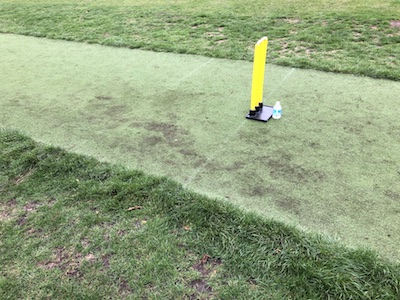35/35 game between the club members who went on tour to Portugal earlier in the season and those who stayed at home. Tourists 152 ao from 30.2 overs. Home Birds 153/6 from 29.4 overs.
The Plastics are the first team I umpired for back in May last year and I was planning on doing a few more for them this year, but events conspired against me. One match was cancelled because the opposition couldn’t book a pitch; one was cancelled because the pitch was double-booked; one I had to pull out of; and finally, this match went ahead.

This late in the year it gets dark early so we started as early as possible, as soon as the various football training groups had left the field. The field was wet, and I’m glad we were playing on an astro-turf pitch, as the rest of the the strips across the square were unplayable. It was chilly, and plenty of fielders wore woolly hats and coats, much to the amusement, I am sure, of some of the occasional spectators who stopped to watch for a few minutes. The field is on a slope, with one end of the pitch lower than the other. Bowling up-hill was hard work, and bowling down-hill was rather bouncy. The markings on the pitch were very faint. There was no visible return crease at either end, the popping crease was just about visible from behind the stumps, but from square leg it couldn’t be seen at all. I did the bowler’s end throughout, and only one of my many temporary colleagues had to judge a run-out, which he said was clearly not-out.
There were many wides and no-balls, including for bowling off the strip several times, as all but one of the Home Birds had a go, one getting three no-balls in his over (but also a wicket, and no other runs, so it was almost a wicket-maiden). There were also several dropped catches, at least some of which can legitimately be put down to – as can some of the wayward bowling – everyone’s fingers being frozen, and also some misses in the field from, quite reasonably, not wanting to dive into cold muddy puddles. The Dukes ball used in the first innings held up well, but the Gray Nicolls ball used in the second innings developed a large ridge around the seam as the wet leather swelled up which just looked weird, both in the hand and when the ball was in flight. I reminded them that they could ask for a ball change, and we could have switched to the ball used in the first innings, but everyone was happy to continue. I expect that that helped it to swing a bit more than it would have otherwise but there wasn’t much unexpected seam movement and no very fast bowling where that might have mattered more. According to one of the players whose Sussex league uses Gray Nicolls balls this is a common problem – and one that I’ve not seen with the Dukes and Readers that are used in the matches I normally umpire.
Late in the Home Birds’ innings it got very dark, so much that if the Tourists had brought a fast bowler on I think I would have had to tell them no. When rain was added to the darkness I reluctantly took the players off. Thankfully it didn’t last long, and as the squall blew past the dark cloud went too and we finished with an even wetter field but in good light.
I was a bit rusty even though it was only a month since my previous game. I don’t think I made any terrible mistakes (although people were most miffed that I didn’t give an LBW that they were all sure was hitting leg stump; I wasn’t sure if it was just tickling the stump or just missing, so I couldn’t give it) but I found myself having to think harder than normal, at least at the start of the game.
It was an enjoyable, not very serious game to end a strange season on. I feel that I’ve improved as an umpire compared to last season. Still lots more to learn, of course, and I do hope that training courses are back on before next season starts.